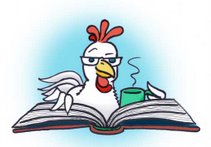[Note: I promised a post on Robert’s Snow this week, but am postponing it once more as Halloween waits for no blogger. If you just can't wait, take a look at this post--and many others around the kidlitosphere--for a quick overview.]
Spend any time around kids in first or second grade who are looking for books, and you’re sure to hear a request (or two, or seventy-five) for scary stories. Especially as the end of October draws nigh. Now, as children’s librarian Adrienne has rightly pointed out, not everyone likes to be scared. But more than once I’ve had some tiny, pudgy-cheeked child turn his or her adorable angel face away in utter scorn of whatever mildly frightening title I’ve proffered, demanding instead “Something REALLY scary.”
This presents the thoughtful librarian or relative with a book-recommending dilemma: if you’re too weenie about offering up scary stuff, the kid will decide you are just another clueless grownup and stomp off on his or her own to find the most irritating and/or product-placement-laden book possible, and then demand that someone read it to them over and over until all family members are driven insane. On the other hand, accede too readily to the “REALLY scary” imperative and as likely as not the child will end up having nightmares and/or hiding the book under a pile of junk in the basement so as to be spared the scary sight of it.
So, for those parents (and kids) who don’t have a taste for insipid junk, night terrors, or library replacement fees, here are a few picture books and early readers to take a look at. None of them are Halloween books per se, but they all aim for that sweet spot beloved of many kids at this time of year: scary enough…but not TOO scary.
King o’ the Cats, retold by Aaron Shepard. This retelling of an old English tale features, among other things, a spooky feline funeral in a church. The author even provides a readers’ theatre script of the story on his website.
Black Lagoon series, by Mike Thaler. Every book in this series follows the same pattern: a kid recounts the terrible, gruesome, scary things he’s heard about the (teacher, principal, librarian, custodian, bus driver…) only to be disabused by the actual niceness of the grownup in question. I used to read The Librarian from the Black Lagoon to 1st graders at the beginning of every year, and they loved it even when they didn’t understand all the jokes. My favorite part is how if you talk too much…the librarian laminates you! Heh, heh, heh.
The Spider and the Fly, by Mary Howitt and Tony DiTerlizzi. A gloriously creepy illustrated version of the 19th-century poem that speaks to the goth in us all. I know one very young kid who loved this book so much she simply took it home from the library and refused to return it.
For the rest of the year. Her mom wasn't thrilled, but I bet the illustrator would be if he knew.
Frankenstein Makes a Sandwich, by Adam Rex. In one gleefully silly (and perfectly illustrated) poem after another, monsters do things that you don’t usually see them doing: the Mummy demands a bedtime story before his eternal rest; the Phantom of the Opera (in a particularly crowd-pleasing running joke) gets a series of songs stuck in his head; and of course there is the titular sandwich. This is one of those books that is sophisticated enough for middle-schoolers to enjoy, but younger kids go crazy for it too even if some of it is over their heads.
Precious and the Boo Hag, by Patricia McKissack. Precious’s brother is just teasing her with his stories about the Boo Hag…or is he? I have to admit that this one is my favorite out of all of these. It is juuuust the right amount of scary, has a great refrain, a great story, and a spirited and smart heroine.
[Next week: for real, the big idea behind some little snowflakes.]
